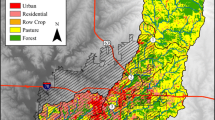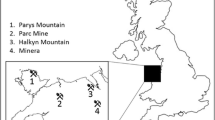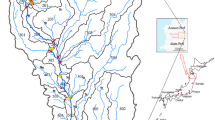Abstract
Seasonal and spatial variation of metal loads can be significant in mining-impacted mountain watersheds in the western US due to a number of complex physical and biogeochemical factors. Anthropogenic influences, such as seasonal water diversion for municipal supplies, can increase this variability further. This study evaluates the seasonal and spatial variation of metal loads from estimated natural flows in a typical Rocky Mountain watershed impacted by historic hardrock mining and municipal water diversions: the Upper Tenmile Creek Watershed near Helena, Montana. Restoration of natural flows is being considered as part of broader watershed restoration measures, and an understanding of the variation in loads resulting from these flows is needed for restoration planning and design. Estimates of tributary and metal point and nonpoint source natural flows to the creek were used with representative total metals (cadmium, copper, lead, and zinc) concentration data for model input and to evaluate the variation of input loads. These loads were evaluated at key locations in the watershed for two seasons: spring snowmelt high flow in June and summer low flow in August. The Water Quality Analysis Simulation Program was used to model the resulting variation of total and dissolved metal loads with distance along the mainstem for the two seasons. Results show that total metal loads to the creek vary among input locations by up to >9,700-fold in June and up to >740-fold in August for copper. Several tributaries have the greatest loads during both seasons, although adits often exhibit the highest concentrations. For all locations, average input loads are up to 46 times higher in June for copper. Total and dissolved metal loads generally increase with distance along the mainstem and vary by up to >320-fold in August and up to >118-fold in June for zinc. Along the mainstem, average total loads are up to 68 times higher in June for lead. Many watershed and biogeochemical processes contribute to this variation, including variability in estimated natural flows, partitioning of metals between the dissolved and particulate phases, and attenuation in the hyporheic zone. Dissolved phases constitute a large proportion of the total metals and follow patterns very similar to those for total loads along the mainstem, especially for cadmium and zinc. Seasonal load differences are greatest for copper and lead because of greater sorption to solids and particulate loads during high flow associated with increased erosion and transport of solids.








Similar content being viewed by others
References
Allison JD, Allison TL (2005) Partition coefficients for metals in surface water, soil, and waste. US EPA Office of Research and Development, EPA/600/R-05/074, pp 93
Bencala KE (2000) Hyporheic zone hydrological processes. Hydrol Process 14:2797–2798
Bencala KE (2005) Hyporheic exchange flows. In: Anderson MG (ed) Encyclopedia of Hydrological Sciences, vol 3(10). Wiley, New York, pp 1–7 (Chap. 113)
Butler B (2005) Assessing the fate and transport of metals in a high-gradient acid-mine drainage impacted mountain stream, North Fork Clear Creek, Colorado. Unpublished Ph.D. Dissertation, Colorado School of Mines, Department of Environmental Science and Engineering, Golden
Caruso BS (2003) Water quality simulation for planning restoration of a mined watershed. Water Air Soil Pollut 150(1–4):221–234
Caruso BS (2004) Modeling metals transport and sediment/water interactions in a mining-impacted mountain stream. J Am Water Resour As 40(6):1603–1615
Caruso BS, Cox TJ (2008) Modeling effects of natural flow restoration on metals fate and transport in a mountain stream impacted by mine waste. J Am Water Resour As 44(3):535–551
Caruso BS, Ward RC (1998) Assessment of nonpoint source pollution from inactive mines using a watershed-based approach. Environ Manage 22(2):225–243
Caruso BS, Cox TJ, Runkel RL, Velleux ML, Bencala KE, Nordstrom DK, Julien PY, Butler BA, Alpers CN, Marion A, Smith KS (2008) Metals fate and transport modeling in streams and watersheds—state of the science and USEPA workshop review. Hydrol Process 22(19):4011–4021
CDM (Camp Dresser and McKee) (2001a) Draft remedial investigation report for Upper Tenmile Creek Mining Area Superfund site, Lewis and Clark County, Montana. US EPA, Denver
CDM (2001b) Draft feasibility study report for Upper Tenmile Creek Mining Area Superfund Site, Lewis and Clark County, Montana. USEPA, Denver
Church SE, von Guerard P, Finger SE (eds) (2007) Integrated investigations of environmental effects of historical mining in the Animas River Watershed, San Juan County, Colorado. USGS Prof Paper 1651, pp 417–495
Cleasby TE, Nimick DA (2002) Streamflow, water quality, and quantification of metal loading in the Upper Tenmile Creek Watershed, Lewis and Clark County, West-Central Montana, September 1998. USGS WRI report 02-4072, pp 64
Collienne RH (1983) Photoreduction of iron in the epilimnion of acidic lakes. Limnol Oceanogr 28:83–100
du Bray EA (ed) (1995) Preliminary compilation of descriptive geoenvironmental mineral deposit models. USGS OFR 95-0831, available at http://pubs.usgs.gov/of/1995/ofr-95-0831/
Environment Agency (2006) Attenuation of mine pollutants in the hyporheic zone. Science Report SC030155/SR6, Bristol
Farag AM, Nimick DA, Kimball BA, Church SE, Harper DD, Brumbaugh WG (2007) Concentrations of metals in water, biofilm, benthic macroinvertebrates, and fish in the Boulder River Watershed, Montana, and the role of colloids in metal uptake. Arch Environ Con Toxicol 52:397–409
Gammons CH, Nimick DA, Parker ST, Cleasby TE, McCleskey RB (2005) Diel behavior of iron and other heavy metals in a mountain stream with acidic to neutral pH: Fisher Creek, Montana, USA. Geochim Cosmochim Acta 69:2505–2516
Gammons CH, Milodragovich L, Belanger-Woods J (2007) Influence of diurnal cycles on metal concentrations and loads in streams draining abandoned mine lands: an example from High Ore Creek, Montana. Environ Geol 53:611–622
Gandy CJ, Smith JWN, Jarvis AP (2007) Attenuation of mining-derived pollutants in the hyporheic zone: a review. Sci Total Environ 373:435–446
Hammarstrom JM, Smith KS (2002) Geochemical and mineralogic characterization of solids and their effects on waters in metal mining environments. In: Seal RR II, Foley NK (eds) Progress on geoenvironmental models for selected mineral deposit types. USGS OFR 02-195, available at http://pubs.usgs.gov/of/2002/of02-195/
Hazen JM, Williams MW, Stover B, Wireman M (2002) Characterization of acid mine drainage using a combination of hydrometric, chemical and isotopic analyses, Mary Murphy Mine, Colorado. Environ Geochem Health 24(1):1–22
Kepler DA, McCleary EC (1994) Successive alkalinity-producing systems (SAPS) for the treatment of acidic mine drainage. In: Proceedings of international land reclamation and mine drainage conference, USBM SP 06A-94, pp 195–204
Kimball BA, Runkel RL, Walton-Day K, Bencala KE (2002) Assessment of metal loads in watersheds affected by acid mine drainage by using tracer injection and synoptic sampling: Cement Creek, Colorado, USA. Appl Geochem 17:1183–1207
Kimball BA, Runkel RL, Cleasby TE, Nimick DA (2004) Quantification of metal loading by tracer injection and synoptic sampling, 1997–98. In: Nimick DA, Church SE, Finger SE (eds) Integrated investigations of environmental effects of historical mining in the Basin and Boulder Mining Districts, Boulder River Watershed, Jefferson County, Montana. USGS Prof Paper 1652, pp 192–263 (chapter D6)
Kimball BA, Bianchi F, Walton-Day K, Runkel RL, Nannucci M, Salvadori A (2007) Quantification of changes in metal loading from storm runoff, Merse River (Tuscany, Italy). Mine Water Environ 26:209–216
Langmuir D, Chrostowski P, Vigneault B, Chaney R (2004) Issue paper on the environmental chemistry of metals. Contract #68-C-02-060, US Environmental Protection Agency, Washington, DC
Mayes WM, Gozzard E, Potter HAB, Jarvis AP (2008) Quantifying the importance of diffuse minewater pollution in a historically heavily coal mined catchment. Environ Pollut 151:165–175
Medine AJ (2003) Modeling the effectiveness of remedial alternatives to reduce mine waste impacts on North Clear Creek, Colorado (final report), prepared for USEPA, NRMRL—Land Remediation and Pollution Control, Cincinnati, OH, order No. 2C-R351-NASA
Medine AJ, Martin JL, Sopher EJ (2002) Development of the metal speciation-based metal exposure and transformation assessment model (META4): application to copper and zinc problems in the Alamosa River, Colorado. In: Lipnick RL, Mason RP, Phillips ML, Pittman CU (eds) Fate and transport of chemicals in the environment: impacts, monitoring and remediation. ACS, Washington DC
Morris JM, Nimick DA, Farag AM, Meyer JS (2005) Does biofilm contribute to diel cycling of Zn in High Ore Creek, Montana? Biogeochem 76:233–259
Morris JM, Farag AM, Nimick DA, Meyer JS (2006) Light-mediated Zn uptake in photosynthetic biofilm. Hydrobiologia 571:361–371
Nimick DA, Gammons CH, Cleasby TE, Madison JP, Skaar D, Brick CM (2003) Diel cycles in dissolved metal concentrations in streams—occurrence and possible causes. Water Resour Res 39(9):1247–1263
Nimick DA, Church SE, Finger SE (eds) (2004) Integrated investigations of environmental effects of historical mining in the Basin and Boulder Mining Districts, Boulder River Watershed, Jefferson County, Montana. USGS Prof Paper 1652, pp 524
Nimick DA, Cleasby TE, McCleskey RB (2005) Seasonality of diel cycles of dissolved trace-metal concentrations in a Rocky Mountain stream. Environ Geol 47(5):603–614
Nordstrom DK (2007) Effects of seasonal and climatic change on water quality from acid mine drainage in the western United States. In: Proceedings of International Mine Water Association Symposium, pp 11–16
Parrett C, Hettinger PS (2000) Streamflow and water-quality characteristics in the Upper Tenmile Creek Watershed, Lewis and Clark County, West-Central Montana. USGS WRI Report 00-4129, pp 71
Plumlee GS (1999) The environmental geology of mineral deposits. In: Plumlee GS, Logsdon MJ (eds) The environmental geochemistry of mineral deposits, Reviews in Economic Geology, vol 6A. Society of Economic Geologists, Littleton, pp 71–116
Plumlee GS, Smith KS, Montour MR, Ficklin WH, Mosier EL (1999) Geologic controls on the composition of natural waters and mine waters draining diverse mineral-deposit types. In: Filipek LH, Plumlee GS (eds) The environmental geochemistry of mineral deposits, Reviews in Economic Geology, vol 6B. Society of Economic Geologists, Littleton, pp 373–432
Runkel RL, Kimball BA (2002) Evaluating remedial alternatives for an acid mine drainage stream: application of a reactive transport model. Environ Sci Technol 36(5):1093–1101
Runkel RL, Kimball BA, McKnight DM, Bencala KE (1999) Reactive solute transport in streams: a surface complexation approach for trace metal sorption. Water Resour Res 35(12):3829–3840
Runkel RL, McKnight DM, Rajaram H (2003) Modeling hyporheic zone processes. Adv Water Resour 26:901–905
Seal RRII, Hammarstrom JM (2003) Geoenvironmental models of mineral deposits: examples from massive sulfide and gold deposits. In: Jambor JL, Blowes DW, Ritchie AIM (eds) Environmental aspects of mine wastes, short course handbook, vol 31. Mineralogical Association of Canada, Ottawa, pp 11–50
Seal RR II, Foley NK (eds) (2002) Progress on geoenvironmental models for selected mineral deposit types. USGS OFR 02-195, available at http://pubs.usgs.gov/of/2002/of02-195/
USEPA (US Environmental Protection Agency) (1996) The metals translator: guidance for calculating a total recoverable permit limit from a dissolved criterion. EPA 823-B-96-007
USEPA (1997) EPA’s national hardrock mining framework. EPA 833-B-97-003
USEPA (2007) Framework for metals risk assessment. EPA 120/R-07/001
USEPA (1989) Briefing report to the EPA Science Advisory Board on the equilibrium partitioning approach to generating sediment quality criteria. EPA 440/5-89-002
USEPA and MDEQ (Montana Dept of Environmental Quality) (2002) Record of Decision, Upper Tenmile Creek Mining Area Superfund Site, Lewis and Clark County, Montana
Velleux ML (2005) Spatially distributed model to assess watershed contaminant transport and fate. Unpublished Ph.D. Dissertation, Colorado State University, Department of Civil Engineering, Ft Collins
Velleux ML, Julien PY, Rojas-Sanchez R, Clements WH, England JF (2006) Simulation of metals transport and toxicity at a mine-impacted watershed: California Gulch, Colorado. Environ Sci Technol 40:6996–7004
Wilkin RT (2008) Contaminant attenuation processes at mine sites. Mine Water Environ 27:251–258
Wool TA, Ambrose RB, Martin JL, Comer EA (2001) Water Quality Analysis Simulation Program (WASP) version 6.0 draft: user’s manual. http://www.epa.gov/athens/wwqtsc/html/wasp.html. USEPA, accessed April 2008
Zaramella M, Marion A, Packman AI (2006) Applicability of the transient storage model to the hyporheic exchange of metals. J Contam Hydrol 84:21–35
Acknowledgments
The authors would like to thank Dr. Tim Cox for helping to develop, calibrate and validate the WASP model and initial simulations, and the anonymous reviewers for the very useful comments on previous versions of this paper.
Author information
Authors and Affiliations
Corresponding author
Rights and permissions
About this article
Cite this article
Caruso, B.S., Bishop, M. Seasonal and Spatial Variation of Metal Loads from Natural Flows in the Upper Tenmile Creek Watershed, Montana. Mine Water Environ 28, 166–181 (2009). https://doi.org/10.1007/s10230-009-0073-9
Received:
Accepted:
Published:
Issue Date:
DOI: https://doi.org/10.1007/s10230-009-0073-9




